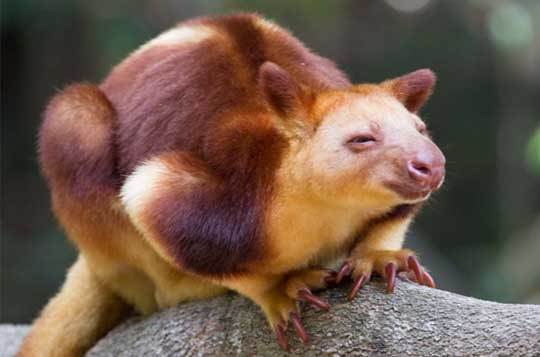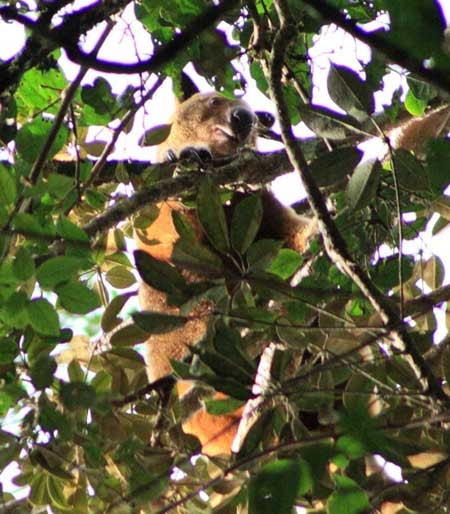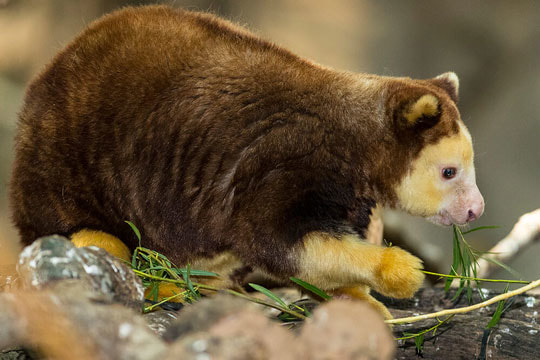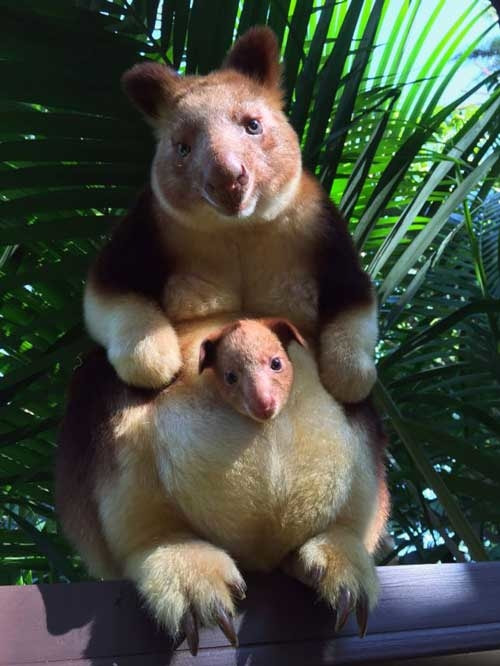|
In honor of the upcoming re-release of Diffusion, today's awesome animal is the Tree Kangaroo. Way back in 2016, I briefly described these creatures in one of my newsletters, but now it's time to give them the full treatment. After all, tree kangaroos are perhaps the most iconic creature of the Diffusion series. I take a toy tree kangaroo to book signings, and one is included on the copyright page of the new versions of the Diffusion books: It is high time I expound upon this creature’s awesomeness. Yes, tree kangaroos are real! They live on the island of New Guinea, but also in very northern Australia and some of the Indonesian islands. Why are tree kangaroos so cool? Well, because they’re kangaroos—that live in trees! When Australian Aborigines and Papuan (New Guinea) natives told early European explorers about tree kangaroos, the explorers refused to believe the stories. You have to admit it seems pretty unlikely, right? So what the heck is a Tree Kangaroo?? Tree kangaroos are marsupials, in the genus Dendrolagus. There are about 14 different species, but this is one of very few types of large mammals with species still being discovered. Most tree kangaroos are about the size of a housecat. They are a fascinating example of divergent evolution (when groups of similar creatures become isolated and gradually diverge in form and function). Long ago, groups of ground-dwelling kangaroos became isolated in areas of dense tropical forest, as opposed to the open grasslands more typical for kangaroos. Once isolated in rainforest areas, they developed the ability to climb trees. Amazing facts about Tree Kangaroos These creatures eat, sleep, and breed in the treetops, but that doesn’t mean they live a comfortable existence. First of all, I imagine breeding in the treetops requires some caution (yikes!). Second, they seem to be a tasty meal for their primary predator, the amethystine python (which has a habit of hugging much too tightly). Third, natives hunt them for food (In New Guinea, "the man who has successfully hunted a tree-kangaroo has greatness bestowed upon him. He has conquered the largest, most prestigious and human-like marsupial known to his people." [Tim Flannery, from the awesome book, Throwim Way Leg]). And fourth, they depend on pristine rainforest, and if you haven’t heard, rainforests are getting smaller every day (a real bummer). Tree kangaroos are reclusive. Some are extremely rare and live in places so remote that they are unusually tame, as they have never learned to fear humans. Just a few days ago, National Geographic published an article about the Wondowoi Tree Kangaroo, a species that had not been spotted since 1929 (ninety years ago!). It was thought to be extinct, until an amatuer botonist led an expedition into the nearly-impenetrable bamboo forests of the Wondiwoi Mountains of West Papua to find it. After much searching, he took the first ever photographs of this species: The Papuan people of New Guinea have numerous ancient myths about tree kangaroos, some of which play a role in the Diffusion novels. For example, one of the main characters of the novels is a tree kangaroo named Mbaiso (at least it looks like a tree kangaroo... all is not what it seems in Diffusion). The name comes from a rare tree kangaroo, Dingiso mbaiso, which is revered by the local Moni people as an ancestor. When describing encounters with these animals, the tribesmen hunters say the creatures sit up, whistle, and hold up their paws in greeting. So the Moni believe the creatures are ancestor spirits who recognize them. Another interesting story, this one about the Matschie’s Tree Kangaroo, is that the creature has a special power. If you think of the girl you love before you let your arrow fly to shoot this tree kangaroo, at the moment the arrow pierces the animal’s body, that’s when the girl will fall in love with you. Below is the Matschie's tree kangaroo: Tree kangaroos really are adapted to life in the trees. Compared to ground kangaroos, they have longer, curved nails for gripping the bark. Their hind feet are longer, and they have spongy, padded grips on their palms and the soles of their feet. Perhaps most striking is their tail. It is longer and heavier than those of ground kangaroos, which gives them better balance as they climb. When they climb straight up a tree trunk, they wrap their forearms around the tree and use their powerful hind legs to "hop" up the tree. They are terrific jumpers. They can leap from one branch to another that is thirty feet (9m) below them. And, this may be hard to believe, but they can leap to the ground from as high as sixty feet (19m) without getting hurt! Considering adults can weigh 25 to 30 pounds (11 to 14kg), this is amazing! Check out this fun Animalogic video about Tree Kangaroos. As mentioned above, tree kangaroos are marsupials. And you know what that means, right? It means they give birth to their babies very early, and then the babies develop in an external pouch. The babies are only the size of jellybeans at birth. At that point, about the only parts of their external anatomy that are well developed are their hands and mouth. They use their hands to crawl to the pouch, then they attach their mouth to a nipple and hang on. For a long time. Astoundingly, baby tree kangaroos stay in the mother's pouch for up to 275 days. And then, after they come out, they are not weaned for up to another 240 days! One more little tidbit. You may have noticed that tree kangaroos look quite a bit like teddy bears. To illustrate how true this is, recently a photo emerged on the internet. It was taken at the Perth Zoo, of a mother Goodfellow's tree kangaroo with a baby in her pouch (the first tree kangaroo baby born at the zoo in 36 years). The creatures looked so cute and teddy-bear-like that many people thought the photo was a fake, just a photo of a stuffed toy. But, of course, the photo was indeed real: So, the Tree Kangaroo deserves a place in the L.A.H.O.F. (Legit Animal Hall of Fame). FUN FACT: The word legit is, of course, a reduction of legitimate, which means "conforming to the law or to the rules." The earliest citation for use of the shorter version, legit, is from 1897. But in recent years it has been used as a slang word to mean that something is either credible or that it is cool. I think this word is appropriate for tree kangaroos because some people are surprised that these creatures are even real. AND, because these creatures are definitely cool! So, legit is another way to say awesome! Photo Credits:
250-million-year-old bacterium - Bioprocess Online Goodfellows Tree Kangaroo #1 - Currumbin Wildlife Sanctuary Wondowoi Tree Kangaroo - Michael Smith (National Geographic) Matschie's Tree kangaroo- San Diego Zoo Baby Goodfellow's Tree Kangaroo in pouch - ZooBorns Goodfellow's Kangaroo and baby - Perth Zoo
1 Comment
Belinda Earl Turner
10/11/2018 08:57:58 am
Legit!🐱❤️🦋
Reply
Leave a Reply. |
Stan's Cogitations
Everyone needs a creative outlet. That's why I write. Archives
July 2024
|







 RSS Feed
RSS Feed